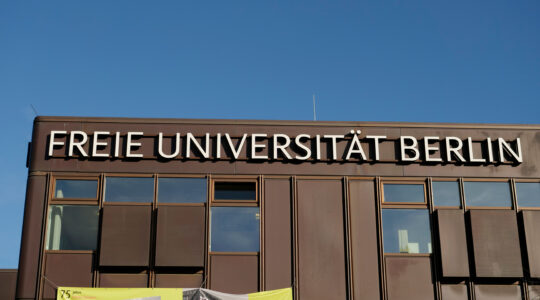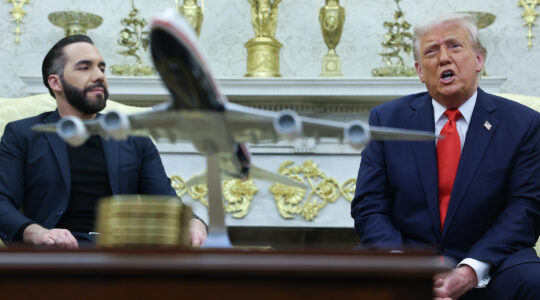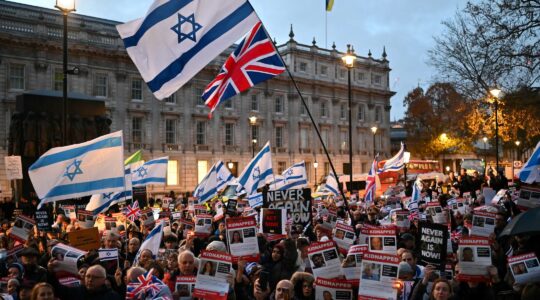PARIS (JTA) – Ever since Mohammed al-Dura was shot and killed at Gaza’s Netzarim Junction on Sept. 30, 2000 amid Israeli-Palestinian fighting, claims that the boy’s death was staged for prime-time TV have struggled for credence outside the Jewish world.
One French media watchdog who was especially strident in making this claim, Philippe Karsenty, paid a heavy price for his advocacy: He was sued for libel by the TV station that shot the al-Dura footage, France 2 TV, and slapped with fines totaling nearly $7,000. The 2006 ruling found Karsenty guilty of libel for claiming France 2 TV’s report was “pure fiction.”
But on Wednesday, Karsenty was vindicated when a Paris appeals court overturned this original judgment against him.
“It is a great day for the freedom of expression in France, the freedom of media and the truth in the media,” Karsenty told JTA after the ruling.
The move lent new credence to the claims by Karsenty and others that the iconic shooting of the 12-year-old Palestinian boy, which fanned the flames of the second intifada, was manipulated by video editing.
The ruling “means there is a strong chance that I’m right,” Karsenty said.
The court’s decision said Karsenty, director of a group called Media Ratings, had the right to accuse France 2 TV and its Jerusalem correspondent, Charles Enderlin, of manipulating the video of al-Dura.
The video in question showed al-Dura and his father cowering in terror while trying to shelter themselves from gunfire. The film then cut to a slumped, motionless Mohammed lying in his father’s lap.
Enderlin, narrating the video shot in Gaza by a France 2 cameraman, pronounced the boy dead and said Israel was responsible.
The footage became an iconic image used around the world to vilify Israel and, in some cases, Jews.
“Even I cried when I saw those images,” said Sammy Ghozlan, a French Jewish leader and the president of the National Bureau of Vigilance against Anti-Semitism. “They were everywhere, and they set off the surge of anti-Semitism in France.”
But the circumstances of the boy’s death later came under question. Israel, after initially apologizing for the incident, said a subsequent investigation showed its troops could not possibly have struck the boy from their positions that day.
“Events could not have occurred as they were described by the network’s reporter, Charles Enderlin, since they contradict the laws of physics,” Israeli government spokesman Danny Seaman wrote in a letter to The Associated Press.
Activists raised further doubts about the film’s authenticity when they discovered Enderlin had been in Ramallah the day of the filming, and that a freelance Palestinian photographer had shot the footage.
Additional footage, which was not included in the broadcast by the French network, also appeared to show the al-Dura boy lift his head and open his eyes after being pronounced dead. France 2 TV had refused to make that footage public until ordered to show it to a French court last November.
Other video reports by Reuters on the day of the Gaza clash showed groups of young Palestinian men staging scenes where they were carried into ambulances as if seriously wounded, then emerging from the ambulances uninjured and laughing.
Even as Karsenty celebrated his courtroom victory this week, France 2 appealed Wednesday’s ruling to the Final Court of Appeals, Paris officials said Thursday.
Karsenty said he wasn’t too concerned, and that the vindication of his claims was sweet given that few paid attention to, or believed, his claims – particularly in France.
Few french Jewish groups embraced his cause, and Jewish groups in the United States were slow to.
Last fall, France 2’s communications director, Christine de la Vena, told JTA, “Everyone has forgotten about this case except this man in the hearing and a couple of others who refuse to give it up. Only in France could a couple of individuals cause so much trouble.”
Richard Prasquier, the president of the CRIF umbrella group of French Jews, eventually did offer the CRIF’s backing to Karsenty, and several U.S. Jewish groups touted his claims.
The American Jewish Committee and the Zionist Organization of America applauded Wednesday’s ruling. The ZOA will honor Karsenty with its Ben Hecht Journalism Award in New York this November.
Karsenty and many of his supporters said they hope this week’s ruling will help bring the truth behind the al-Dura shooting to light.
“I’m happy that the judge recognizes we have a right to ask questions about the media, and that France 2 isn’t beyond any suspicion,” said Jacque Tarnero, a co-director of the documentary film “Decipherings” that focuses on the French media’s portrayals of Israel during the first few years of the second intifada. “But now we still don’t know the truth or the facts.”
Tarnero called for the release of additional footage of the al-Dura shooting never made available by France 2. He called for a deeper investigation of the report, which became a symbol of the “supposed barbarism of Israelis who killed children.”
“Now it is time for France 2 to acknowledge that it created and is continuing to perpetuate the worst anti-Semitic libel of our era,” Karsenty said.
“It’s the responsibility of the French government, and ultimately the responsibility of the French president, Nicolas Sarkozy, to finally reveal the truth.”
JTA has documented Jewish history in real-time for over a century. Keep our journalism strong by joining us in supporting independent, award-winning reporting.





